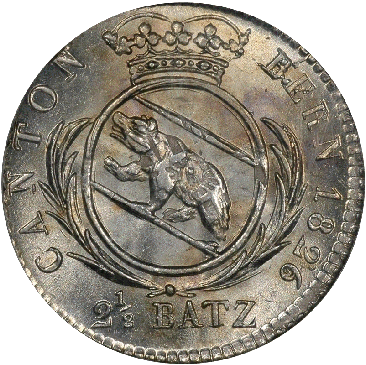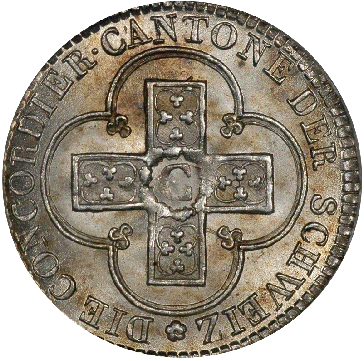

Swiss minor coins from the 1820's are very affordable in mint state grade. I collect the denomination called Batzen. The 5 Batzens are my favorites. I'm working on a set collecting one 5 Batzen coin from each Swiss Canton that minted that denomination. They are a nice size. and can run in price from $125 in MS-63 to $400 in MS-66. depending on which Canton it was minted for. If you're a variety collector. then the 5 Batzen coins will not disappoint you. The main varieties are in the spelling of the denomination Batzen. Some are spelt Batz and some are Baz. This is were the price difference comes into play. Try to make a set that would include all varieties. If you would like to put a specialized set together. Then go with the following denominations. Batzen. 2Y:. Batzen and 5 Batzen. I would also include all the verities as that would make your set a very specialized one. Also. you do not have to buy each coin in mint state condition. But, I would not buy them in grades lower than AU.
One important thing I should point out. If your going to buy raw coins than study this series very good. You will need to build your knowledge base. Most coins within this series can look very crude even in MS-66 condition. Look at the photos included within this article and you will understand what I mean. Having a good knowledge base with these coins will be a pulse for you. How is this? Most dealers do not have a good knowledge base on these coins. So you could buy a mint state coin for AU or EF prices. due to the fact that most dealers do not know how to grade these coins. I've looked at many Swiss 21/2 Batzen and 5 Batzen pieces. It seems as though the Swiss mints used the dies until they fell apart. Now. it was common in those days to use the dies until they were so worn down that the coin strikes were very weak. Most of the minor coinage struck in the Canton of Bern. can look very crude. I've seen strong strikes with PL surfaces and graded MS-65 (by PCGS & NGC). that have parts of the design missing, very strong strike through, strong letter and date doubling ... . etc ... etc. This is very good for variety collectors. I have a 5 Batzen minted for the Canton of Bern, that is graded NGC MS-65 PL. Most of the obverse design of the bear's back leg is missing. It has strong doubling of the obverse lettering. Now. this takes me to the next part of this subject at hand. PCGS and NGC do not state the mint errors or PL surfaces on most world coins. I've seen world coins sent in with very obvious mint errors and PL and DMPL surfaces. and the errors or PL surfaces are not shown with the grade (such as MS-65 PL). This is also good for the collector. Why? Most advanced collectors know that PL surfaces with a strong strike. can bring a premium when sold to another advanced collector that knows a coin like this is highly sought after. I do feel that PCGS and NGC will sooner or later. start to include and mark it on their slab's the mint errors and PL surfaces a world coin may have. This will happen. as high grade world coins are becoming very popular with US collectors.
US coins are to much investor price driven. and most collectors can not afford to pay $3,000.00 for a common date MS-66 or MS-67 Morgan dollar. Even the MS-64 and 65 grades are becoming high in price do to investors.
In closing this article. I have a thought I would like to share. What most collectors do not know, is that 16th to 19th century world coins are affordable, and some of the coins have very low mintages (a lot lower than Morgan dollars and US gold coins). Also, there are hundreds of coins for the variety collector. Within the last ten years. I've seen a growth in world coin collectors. There are more rare and affordable scarce world coins than US coins. There is one bad out look with the growth of collectors of world coins. The investor will start to jump in and push the prices up as they do with popular US coins. So. before its to late. take a good look at world coins. My list to look at would be the following.
1) Austrian/ Hungarian and German 1/4. Taler, 1/2 Taler. Taler and 2 Taler, from the 1500's to the late 1800's.
2) Early 1700's to 1800's Russian Rubles. These are very hot sellers now, but are very pricey
3) The ever so popular Swiss Shooting Thalers from the mid 1800's. These are sought after by advanced collectors specializing in Swiss coinage. These Thalers never go down in value and should be in every world coin collectors collection. Do to there low mintages, never pass up an AU.
4) English and French coins from the 13th to 19th centuries. Can be very pricey
5) Coins from 16th to 18th century Spain. Very, very pricey

